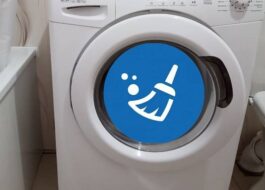Cleaning the Candy washing machine filter
 Like any other, the Kandy washing machine has a debris filter. It should be cleaned in a timely manner. Forgetfulness can result in serious damage to your faithful assistant. From this article you will learn how to clean the filter in a Kandy washing machine.
Like any other, the Kandy washing machine has a debris filter. It should be cleaned in a timely manner. Forgetfulness can result in serious damage to your faithful assistant. From this article you will learn how to clean the filter in a Kandy washing machine.
Cleaning instructions
Washing machines have two debris filters: inlet (inlet) and drain (drainage). The first one purifies the water coming from the water supply into the machine from the impurities it contains (rust, sand, etc.). The second prevents small items that might have been loaded into the washing machine along with laundry from getting into the drain pump.
If there were no drain filter, the drain pump would instantly fail, and blockages would appear in the drain hose.
You can clean the garbage filter yourself; there is no need to call a professional for this. Follow the instructions strictly; this will help you avoid various troubles: from a dirty puddle on the floor to bringing the machine into a completely faulty state.
The first question that arises is: where is the filter on the Kandy machine? It can be found at the bottom - in the front left part of the case. It is covered by a special camouflage panel or a hinged lid, directly behind which there is a hatch. Having found where the filter is located, you need to follow these steps sequentially:
- To gain access to the location you need, move the machine and lift it slightly if necessary. Remove the decorative panel or open the hatch cover. To do this, it is convenient to use a wide knife or a flat-head screwdriver. The closing element is pulled towards itself or moved to the side.

- In washing machines, only in the drum there is no water at all. A small amount of liquid always remains in the system. When dismantling the filter, it will spill out, so place a container under the hole and cover the floor with a rag. If there is an emergency hose, remove it and drain the water.
- Remove filters. To remove the inlet filter, you just need to unscrew the hose; the mesh can be cleaned without removing it, or carefully pulled out using tweezers. The drain filter is closed by a plug; it must be unscrewed. Unscrew the screw fasteners with a screwdriver and pull out the filter completely.
- Clean the filter. Remove large fractions of debris from the filter, rinse the mesh under running water. To prevent rubber seals from becoming deformed, rinse with warm water, not hot.

- Using a flashlight, examine the filter hole and pump pump. Clean the impeller from dirt and objects that have fallen into it. The impeller should rotate freely.
- Place the pump filter in place by carefully assembling it and tightening all screws.
- Test the machine by plugging it in and running the rinse cycle. While the machine is running, carefully observe for leaks. If the machine is leaking, it means something was installed incorrectly.
- Replace the masking panel or close the hatch cover. If the machine was moving, move it to its original position.
What to clean with?
Sometimes a situation arises when the filter cannot be cleaned with water alone. This usually happens if a lot of time has passed since the previous cleaning. What to do with a heavily soiled filter?
In this case, use additional funds. Pour warm water over soda and citric acid at the rate of 20-50 g per liter of water. This solution helps remove scale, rust and mucus.Soak the filter parts in it for a maximum of half an hour, then rub with a sponge and rinse with water. If the plaque is insignificant, it can be cleaned with toothpaste or laundry soap.
Instead of soda and citric acid, special solutions that remove rust are suitable.
Can't unscrew
Sometimes you cannot unscrew and remove the filter due to various objects stuck in it. Hair, socks and handkerchiefs, coins, beads and other small items during washing can end up in the catcher in front of the pump and plug it. Limescale deposits on the threads, which occur if the filter has not been removed for a long time, can also become an obstacle.
In this case, there are three ways to open the garbage filter. Apply them in turn, proceeding to the next method only if you tried the previous one and it did not help. Before you begin, be sure to unplug the machine and close the valve to prevent water from flowing.
1 way. Use pliers or pliers to unscrew the filter cap. There is a handle on it that you need to try to turn using a tool. Manipulations should be carried out very carefully so as not to break the filter part.
Method 2. Lightly tap the drain pump filter cover several times while tilting the washing machine. This method is suitable when:
- The garbage filter cover does not rotate at all;
- partially rotates;
- It can be unscrewed, but it cannot be removed.
Tilt the machine back and lean it against the wall. Tap the dust filter cover and the housing next to it. If the snag is in small objects that have stopped the desired part, then the knock will cause them to move, and you can unscrew and pull out the filter.
3 way.If the previous two methods were unsuccessful, then you need to completely remove the drain pump. The task is to clean the snail and remove the filter. This method is quite complicated - you need to get to the pump, unhook the pump from the volute and through the resulting hole get to the filter.

The design features of certain models of Kandy washing machines allow the drainage pump to be dismantled through the bottom. If it is easily removed or is absent altogether, then it is easier and more convenient to get the snail with the pump in this way. Putting the machine on its side or simply tilting it in the desired direction and resting it on the wall, remove the bottom and find the pump. It is located behind the filter, that is, in the lower part of the housing.
The listed methods should only be used if you are confident in your abilities and have certain skills in repairing various devices. If the filter does not unscrew and you are not very well versed in technology, it is better to call a specialist. It must be remembered that through ignorance you can not only waste time, but also worsen the situation.
Interesting:
Reader comments
- Share your opinion - leave a comment
Categories
Washing machine repair


For buyers

For users

Dishwasher

















Add a comment